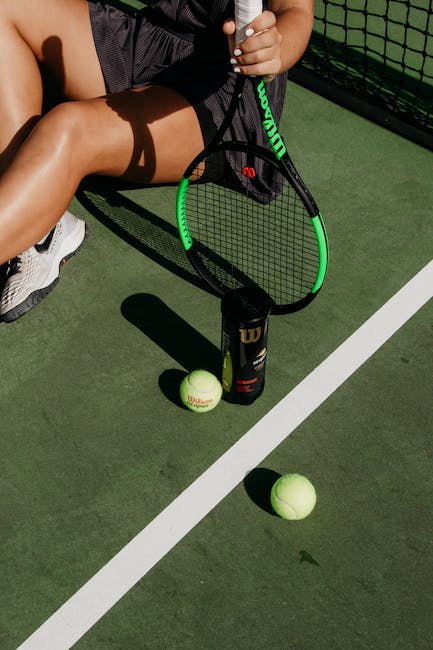Welcome to my guide about lifting weights with tennis elbow, where the only thing worse than the fear of dropping a dumbbell on your head is the fear of dropping it on your elbow. But fear not, my fellow lifters with elbow woes, for I am here to show you the way to pain-free gains with some expert advice and witty commentary. So grab your weights and let’s flex our muscles and our funny bones in equal measure.
Contents
- 1 1. Introduction: Understanding Tennis Elbow and Weightlifting
- 2 2. The Anatomy of Tennis Elbow: What You Need to Know
- 3 3. The Dos and Don’ts of Lifting Weights with Tennis Elbow
- 4 The Dos and Don’ts of Lifting Weights with Tennis Elbow
- 5 4. Tips for Preventing and Treating Tennis Elbow in Weightlifting
- 6 5. Building Strength Safely: A Comprehensive Plan for Weightlifting with Tennis Elbow
- 7 It’s Time to Flex (but not your elbow)
1. Introduction: Understanding Tennis Elbow and Weightlifting
Tennis elbow – it ain’t just for tennis players. It’s the bane of weightlifters everywhere. You know, that pain in the elbow that makes you feel like an 80-year-old grandma every time you try to lift something. If you’re a weightlifter, you’ve probably had a run-in with tennis elbow at least once in your lifting career.
Here are some common questions we get from weightlifters about tennis elbow:
– What is tennis elbow, anyway?
– How do I know if I have it?
– Can I still lift while I have tennis elbow?
Tennis elbow is a condition where the tendons in your elbow get inflamed and irritated. It’s caused by overuse – usually from repetitive motions like gripping or lifting heavy things. So if you’re a weightlifter, you’re basically a walking target for tennis elbow. Congratulations!
If you have tennis elbow, you’ll know it. The most common symptoms are pain and tenderness on the outside of your elbow, and sometimes a weakened grip. It’s not usually a serious condition, but it can be a major pain in the butt if you’re trying to lift heavy weights.
But don’t fret, dear weightlifter friend! You can still lift while you have tennis elbow – you just need to take care of yourself. We’ll get into some tips and tricks later on to help you manage your tennis elbow and keep lifting like a champ. So put down your ice pack and listen up!
2. The Anatomy of Tennis Elbow: What You Need to Know
So, you’ve finally decided to take up tennis but now you’ve got an aching pain in your elbow. Congratulations, you’ve got tennis elbow! But don’t worry, you’re not alone. In fact, it’s estimated that up to 50% of tennis players will experience this pain at some point in their lives. Let’s take a look at the anatomy of tennis elbow and what you need to know.
First things first, tennis elbow isn’t actually caused by playing tennis. Shocking, I know. It’s actually caused by repetitive movements that strain the forearm muscles and tendons. So, basically, if you’re doing anything that involves repeating the same motion over and over again, you’re at risk for tennis elbow. Some common offenders include typing, painting, and even cooking. Who knew that cooking could be so dangerous?
But what exactly is happening in your elbow when you’ve got tennis elbow? Well, the pain is caused by inflammation in the tendons that attach to the lateral epicondyle, which is the bony bump on the outer part of your elbow. This inflammation can cause small tears in the tendons, which can lead to even more pain and discomfort. So, if you’re experiencing pain on the outer part of your elbow that gets worse when you grip something or extend your wrist, you might have tennis elbow.
- Inflammation in the tendons causes the pain in tennis elbow
- Repetitive movements put you at risk
- Typing, painting, and cooking can all cause tennis elbow
Now that you know the anatomy of tennis elbow, it’s time to take some action. But don’t worry, you don’t have to give up your love of tennis or cooking just yet. There are plenty of treatments and exercises that can help alleviate the pain and prevent it from coming back. So, sit back, grab some ice, and let’s get to work on fixing that pesky tennis elbow. Who knows, you might even come out stronger on the other side.
3. The Dos and Don’ts of Lifting Weights with Tennis Elbow
The Dos and Don’ts of Lifting Weights with Tennis Elbow
- DO consult with a professional
- Before grabbing the nearest dumbbell and pretending to be Arnold Schwarzenegger, seek advice from a physiotherapist. They can develop an exercise plan to accommodate your tennis elbow without putting extra strain on it.
- DO use your good arm
- You wouldn’t use a shovel with one hand, would you? Well, the same logic applies to lifting weights. Use your good arm to take on the brunt of the weight while the other arm takes a well-deserved rest.
- DON’T lift heavy
- There’s no shame in starting small when it comes to weights. Don’t aim for a personal best, aim for a personal safe zone. Your tennis elbow will thank you.
- DON’T do repetitive motion exercises
- Your body loves variety, BUT your tennis elbow does not. Avoid doing repetitive motion exercises such as arm curls or push-ups. There’s a whole world of exercises out there, so get creative and switch it up.
- DO warm-up and cool-down
- Just like any other workout, it’s important to warm up and cool down to prevent injuries. Invest in a few resistance bands for your warm-up and some stretching exercises for your cool-down. You’ll thank us later.
4. Tips for Preventing and Treating Tennis Elbow in Weightlifting
Let’s face it, weightlifting can be a pain in the arm – literally. Tennis elbow is a common injury that plagues many weightlifters. But fear not, dear reader! Follow these tips to prevent and treat tennis elbow:
– Proper form is key. Make sure you’re using proper technique when lifting. Incorrect form can put undue stress on your elbows, leading to injury. Take the time to learn the correct way to lift before adding weight to your routine.
– Warm up before you lift. It’s important to get your muscles and joints ready for the work ahead. Take a few minutes to stretch and warm up before hitting the weights. Your arms will thank you.
– Don’t overdo it. Listen to your body. If you’re feeling pain or discomfort, take a break. It’s better to take a day off than to push through the pain and make things worse. Plus, you can use the extra time to catch up on your favorite Netflix shows.
In summary, prevent tennis elbow in weightlifting by using proper form, warming up before lifting, and listening to your body. And if all else fails… switch to yoga. Namaste.
5. Building Strength Safely: A Comprehensive Plan for Weightlifting with Tennis Elbow
So, you love pumping iron, but unfortunately, your elbow is also a big fan of tennis. If you’re someone who suffers from tennis elbow, you probably already know that weightlifting can aggravate the condition and cause even more pain. Don’t worry, though, we’ve got your back (or rather elbow) covered with a comprehensive plan to building strength safely and effectively.
First things first, warming up is crucial to any workout routine, but it is especially important when dealing with a potentially injured joint. Make sure to spend at least 10 minutes on gentle cardio before diving into weightlifting. This will not only increase blood flow to the affected area but also help to loosen up the muscles and tendons surrounding your elbow. And if you’re feeling extra fancy, throw in some dynamic stretches to really get your body warmed up.
Now that you’re all warmed up, let’s talk about the type of exercises you should focus on. The key here is to avoid movements that place excessive stress on your elbow. Instead, opt for exercises that put minimal stress on your joints, such as:
- Compound movements: focusing on big, compound movements such as bench press, squats, deadlifts, and pull-ups, as opposed to isolation exercises that isolate a single muscle
- Lower weight, higher rep: this means using a lower weight and completing more reps per set. This not only helps to build strength but also increases circulation and reduces inflammation in the area
- Modifying exercises: if a particular exercise is causing pain or discomfort, it’s best to modify it or skip it altogether. For example, try doing push-ups with your knees on the ground rather than your feet
With a little bit of patience and attention to detail, there’s no reason why you can’t continue to lift weights and build strength, even with tennis elbow. Just make sure to listen to your body, be gentle when you need to, and most importantly, keep a sense of humor. Because let’s face it, there’s nothing like a good laugh to make the pain feel a little less, well, painful.
It’s Time to Flex (but not your elbow)
Well, congrats! You’ve made it to the end of the article without getting tennis elbow, which means you’re doing something right. Now that you’ve got the inside scoop on how to lift weights like a pro with tennis elbow, it’s time to get pumping those biceps and triceps – just don’t forget to incorporate the tips we’ve given you to avoid re-aggravating your arm.
Remember, when it comes to lifting weights and tennis elbow, slow and steady wins the race. Take your time, listen to your body, and don’t try to lift more weight than you’re ready to handle. With a little patience, perseverance, and proper form, you’ll be back to your best in no time.
So, go ahead and get your sweat on, champ! But, please, let’s not try and high five just yet – we can’t handle another tennis elbow.








Leave A Comment